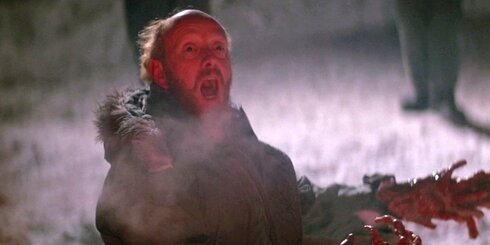A- | A team of Antarctic researchers encounter a parasitic organism that takes over its host. Directed by John Carpenter Starring Kurt Russell, Wilford Brimley, and Keith David Review by Jon Kissel |

Within that Cold War backdrop is the diamond center of unease at The Thing’s slimy heart. The alien presence that the workers and scientists of this Antarctic research station encounter might as well be sent by Mao himself, as it dissolves individuals and turns them into part of an assimilated collective. It’s unclear if, once they’ve been infected, they are active agents provocateur or useful idiots, in the parlance of the times, but, if cornered, they will panic and explode in a desperate tangle of tentacles and sacs. Most of our cast of twelve are unwilling or unable to take on the mantle of leadership in such a dire situation. When no one can be trusted, every action must be over-interrogated for nefarious purposes, and that over-interrogation makes decisions impossible. The only character who can maybe cut through everything is R. J. MacReady (Kurt Russell), the compound’s helicopter pilot, but even he makes critical mistakes in his pursuit of making sure that the alien creature doesn’t make it back to civilization, where it would inevitably infect every life form on the planet.
If the various characters don’t know what they’re doing, Carpenter is in complete control. He plays the viewer expertly with the build and release of tension. Rob Bottin’s creature effects are the star of the film, and Carpenter knows this because they’re used somewhat sparingly. Like Jaws from seven years earlier, the withholding of the monster makes its appearance all the more striking. There’s only five big effects scenes, and they’re spaced to allow for the maximum buildup of dread before that dread is spent in a splash of fluids and torn tissues. In between those scenes, the cast argues over what’s happening at approximately the same level of knowledge as the viewer, set to the heartbeat motifs of Ennio Morricone’s score. The Thing doesn’t tip who’s infected and when, and therefore we don’t know anything more than what the characters do. Even on a second or third viewing, there’s still an intake of breath every time MacReady puts his hot wire into a Petri dish of blood. By placing the viewer in the same investigatory headspace as the characters, Carpenter is melting the walls between the two parties and creating a shared nightmare.
Nightmare is an apt description of the rampaging infection that’s tearing through the compound. Same with the otherworldly scream that the sound team puts in the mouths of the infected. Seeing the creature itself in action, however, must be described in another way for me. I love some toe-curling, squicky, squelching body horror, and this is as squelchy as it gets. Bottin was 22 when he worked as The Thing’s special effects chief, and he did the best work of his life before he could rent a car. Brought to life with a combination of puppets, engineering, and ingenuity, Bottin’s imagination is a horrifying yet delightful place to be. The chest-mouth sequence is timeless, as is the mound of assimilated dogs. Each of these scenes and several others bring a helpless smile to my face as surely as any comedy. When this type of stuff is done well, I can’t help it.
For an isolated cast of twelve, there’s a healthy amount of character building to cram in within the film’s 109 minutes. It’s not able to get into backstories or normal lives at all, but the mixture of stars, future stars, and character actors has enough ability to stand out more than they really need to. Wilford Brimley and Keith David were both relative unknowns at this point, and both convey a physical volatility that makes them unpredictable. Donald Moffat’s Garry fits into a type i.e. the disrespected boss whose leadership is in name only. Norris, played by Charles Hallahan, gets in the film’s most human moment when he rejects leadership and does so in such an honest and earnest way that he isn’t looked down upon after. A lot is conveyed about Clark (Richard Masur) by his close relationship with the dogs. No one would call The Thing’s characterization deep, but there’s enough here to satisfy.
Once the creature sabotages the generator and seals the fate of the surviving characters, the film races to a conclusion too fast, like it throws its hands up and wants to stop filming in the snow. The climactic showdown between MacReady and the creature doesn’t work, both for MacReady’s kiss-off line and because it’s a silly lack of imagination that the creature would be big. It doesn’t appear to create biomass out of nothing, how’d it turn into such a substantial chunk so quickly. Size isn’t what The Thing had been dining out on up to that point, and its sudden reliance on it could’ve been improved on. However, the final scene, where MacReady and David’s Childs are left to freeze to death together, is an anti-climax atop a climax and could not have been improved on. The viewer still doesn’t know more than the characters know. Maybe every part of the creature was incinerated. Maybe it’s waiting in MacReady or Childs, soon to fall back into stasis until that glorious day when it’s thawed out and gets back to its infecting ways. Work out your differences and your tribalism and your paranoia or be assimilated into a throbbing mass of formerly-human tissue. The chest-mouth would’ve been plenty, but Carpenter had to go and make his film that contains a spider-head scurrying off down a hallway about something. That extra effort no doubt plays a part in why The Thing has persisted so long after its release date. A-
 RSS Feed
RSS Feed